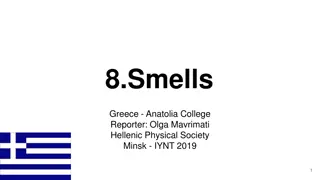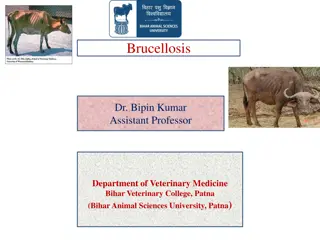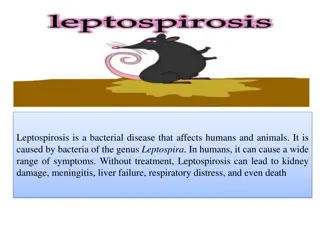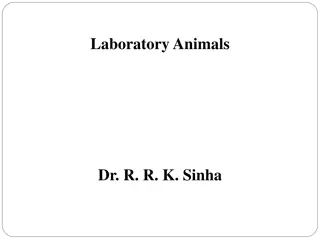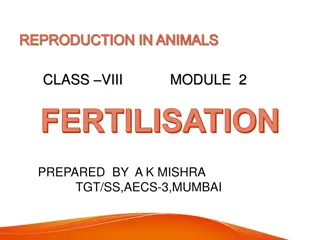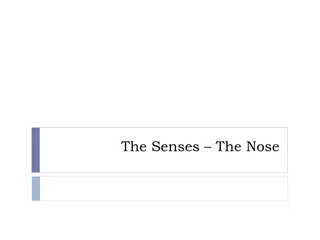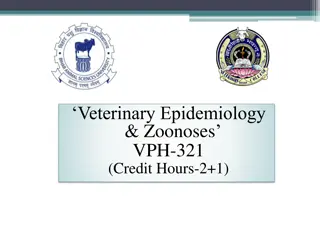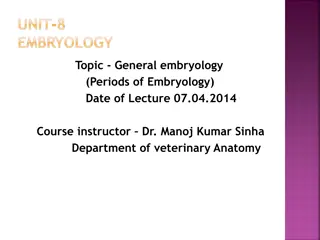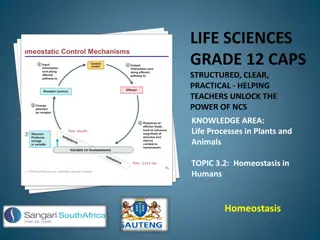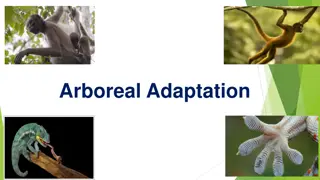Understanding Olfaction: The Sense of Smell in Animals and Humans
Olfaction, the sense of smell, plays a vital role in animals like dogs and rabbits for environmental warning. Humans and primates, although microsomatics, also rely on smell for pleasure and food enjoyment. The olfactory system, including the olfactory mucosa's histological structure and specialized receptors, enables the detection of odors and transmission of signals to the brain.
Download Presentation

Please find below an Image/Link to download the presentation.
The content on the website is provided AS IS for your information and personal use only. It may not be sold, licensed, or shared on other websites without obtaining consent from the author. Download presentation by click this link. If you encounter any issues during the download, it is possible that the publisher has removed the file from their server.
E N D
Presentation Transcript
Smell Smell - -By By Fuldona Fuldona Pandit Pandit
INTRODUCTION The sense of smell or olfaction is well developed in animals like dog and rabbit to give warning of the environmental dangers. Such animals are called macrosomatics. In humans, apes and monkeys the sense of smell is comparatively less developed ,but still it is important for pleasure and for enjoying the taste of food .Therefore ,the humans and primates are called microsomatics.
SITE OF OLFACTION The olfactory stimuli are detected by spacialized receptors located on the free nerve endings of the olfactory nerves which are located in the : Olfactory mucosa of nose in human beings and vomeronasal organ in reptiles and certain animals .
OLFACTORY MUCOSA HISTOLOGICAL STRUCTURE: Histologically, olfactory mucosa consists of three types of cells. 1. RECEPTOR CELLS: About 10 -20 million receptor cells are present in the olfactory mucosa . These cells are bipolar neurons which lie between supporting cells . The dendrites of the receptor cells terminate in a knob from which 6-12 fine cilia project and form a danse mat into the mucous layer of the olfactory mucosa .
Their axons are fine unmyelinated fibres which form the olfactory nerve . Characteristic feature of olfactory receptor cells which differentiate it from other sensory neurons are : These are the only sensory neurons whose cell bodies are closest to the external environment. These cells have a short life span of about 60 days and get replaced by proliferation of basal cells .this natural turn over is a unique feature of thease sensory neurons .
SUPPORTING CELLS: These cells also known as sustentacular cells which are columnar in shape . Microvilli extend from the surface of these cells into the mucous layer covering the olfactory mucosa .these cells secret mucous . Bowman s glands lying just under the basement membrane also secrete mucus .
BASAL CELL: Basal cells are stem cells from which new receptor cells are formed . DISTINGUISHING FEATURES OF OLFACTORY MUCOSA OF NASAL CAVITY : Presence of receptor cells , Presence of Bowman s gland , Absence of rhythmic ciliary beating
VOMERONASAL ORGAN Vomeronasal organ is an accessory olfactory organ found in many animals including mammals . This organ was discovered in 1813, by a danish physician Ludwig Jacobson, hence it is also called Jacobson organ . It is enclosed in a cartilaginious capsule ,which opens into the base of nasal cavity . Olfactory receptors of this organ are sesitive to non-volatile substances such as scents and pheromoes . Vomeronasal organ helps the animals to detect even the trace quentities of chemical .
Impulses from this organ are sent to amygdala and hypothalamus via accessory olfactory bulb . In humans beings ,the vomeronasal organ was considered as vestigial or nonfunctional . Recently ,it is found that this organ is present in the form of vomeronasal pits on the anterior part of nasal septum .
OLFACTORY PATHWAY Axons of bipolar olfactory receptors pierce the cribriform plate of ethmoid bone and reach the olfactory bulb. Here ,the axons synapse with dendrites of mitral cell .Different groups of these synapses form globular structures called olfactory glomeruli . Axons of mitral cells leaves the olfactory bulb and form olfactory tract .olfactory tract runs backward and ends in olfactory cortex ,through the intermediate and lateral olfactory stria .
Olfactory cortex includes the structures ,which form a part of limbic system. These structure are anterior olfactory nucleus , prepyriform cortex ,olfactory tubercle and amygdala.


